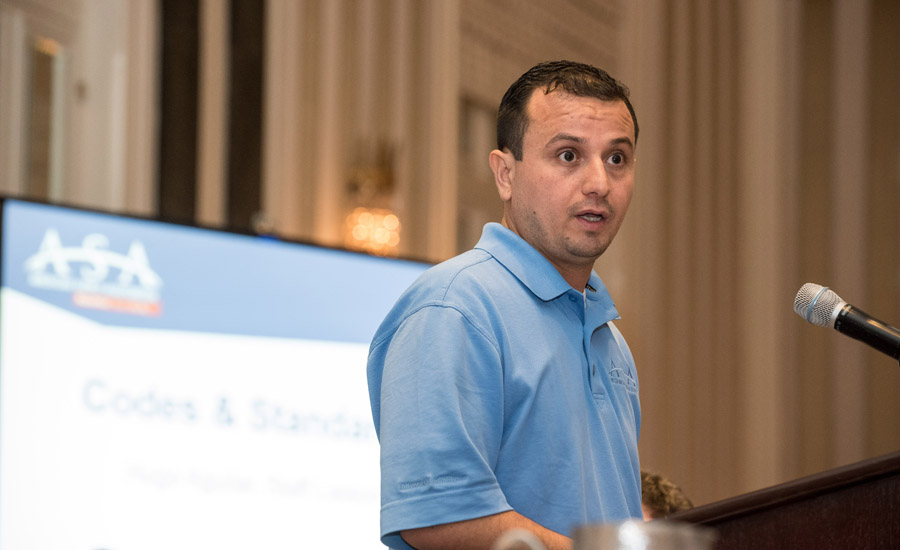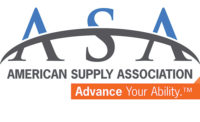Meet Hugo Aguilar, P.E., ASA’s new director of codes and standards

ASA Director of Codes and Standards Hugo Aguilar, P.E.
Hugo Aguilar, P.E., recently joined the American Supply Association as its director of codes and standards. Aguilar worked the past five years as IAPMO’s manager for code-development projects. During his time at IAPMO, Aguilar managed projects pertaining to code development, was the staff liaison on the Uniform Mechanical Code and provided staff support on the UMC, as well as the Uniform Plumbing Code and the Uniform Solar Energy and Hydronics Code. A graduate of Cal Poly Pomona, Aguilar took some time recently to talk to Supply House Times about ASA’s new codes and standards platform and the role he will play with the association.
Why are codes and standards important to PHCP-PVF distribution businesses?
HA: Not staying abreast on codes and standards activities may lead distributors to carry products that do not meet code and therefore can’t be sold. In other words, if there is a particular product that is not recognized or accepted per the model code, distributors will find it difficult to get rid of that product from their stock.
Standard promulgators such as UL, ASME, ASTM, etc., are actively trying to get their listing to a product recognized by the model code or standard and rightfully so. Many times they are successful. The technical committee of the model code may not be aware there are other listings available that are equivalent but are now being eliminated by the code.
If distributors get involved in the code-development process, they can avoid such scenarios from occurring and can serve as the conduit of information that will inform other committees that there are equivalent products available. Distributors also can be the watchdog for their contractor customers and help them avoid purchasing products that are not accepted per the model and having to go through a rigorous and difficult process to get that product accepted by jurisdictions.
What are your goals in the short term from an ASA standpoint with the new codes and standards division?
HA: The first step is to establish a strong Codes and Standards Committee where issues that affect ASA members’ interests can be discussed and then a consensus on the issue identified. Codes or standards such as ASHRAE, NFPA, IAPMO and ICC have different development processes. It can be rather cumbersome to try to understand how they differ. An ASA Codes and Standards Committee will serve as the source of information for our members.
It is worth noting many ASA members already are involved in the process for the codes and standards that affect their products. The goal is to share the knowledge among ASA members so everyone is aware of issues and can react accordingly.
The next step will be to engage in an education and informational campaign to keep members informed on what is happening with code issues, how those issues can impact their businesses and help position members to be able to meet future code changes.
Where would you like to see the ASA codes & standards division at 3-5 years down the road?
HA: Within 3-5 years I envision the division being in the forefront battling codes and standards issues. ASA’s brand will be recognized and will have a huge influence in the codes and standards arena. The codes and standards division will be working together with ASPE, IAPMO, ICC, ASHRAE, PMI and NAHB, to name a few, to address issues that are affecting the industry. Our technical committee will have the availability to use the presence of manufacturers and distributors at the meetings to influence a technical committee.
How does the codes and standards community currently view the distribution part of the supply chain?
HA: The codes and standards community, in my opinion, does not hold a specific view on the distribution and supply chain of the industry. Most of the changes that occur are mainly concentrated around specific products and manufacturers as well as code enforcement. Therefore, the voices and opinions of the distributors and the supply chain are currently not being heard and discussed. That is what will make the ASA Codes and Standards Committee unique in that it will provide that voice that distributors and suppliers need.
As mentioned previously, if a particular code change is adding requirements for a product to be listed to a particular listing, manufacturers who are involved in the process can prepare for this, but distributors may be purchasing products that soon will not be accepted in the field by jurisdictions. This is an issue that has previously occurred. Distributors were left with products that can no longer be sold due to the lead and copper rule. Many distributors were caught short with excess inventory. ASA’s Codes and Standards Committee will bridge the gap that exists between distributors and codes and/or regulations.
Any hot-button topics right now related to codes and standards that you would like to tackle?
HA: In the HVAC industry there are some provisions being added to the mechanical code pertaining to fittings being allowed to be installed embedded in concrete. Another hot-button topic is the limitation of flex duct lengths in the mechanical code. This is an issue that will be discussed during the ASA Codes and Standards Committee to determine which route the committee would like to take.
How will this new part of ASA benefit manufacturers and manufacturers representatives?
HA: Many manufacturers are represented either through other associations or through representation from their staff engineers that sit on committees. However, having another voice from an ASA representative at code meetings can’t hurt, especially when they are seeking support from the code committee on a change that may impact their products. In addition, engaging their distributor customers in the process is a win-win for everyone since we all can be working with one voice that represents our industry.
The ASA Codes and Standards Committee will bring the voices of these sectors of the industry so that each party is aware of the issues and are not blindsided.
What is the importance of being a voting member on such standards as ASHRAE 62.1?
HA: ASHRAE 62.1 is the leading document that addresses health and safety provisions for ventilation systems. The provisions found in ASHRAE 62.1 are directly extracted and incorporated into Chapter 4 of the UMC. Furthermore, it is almost identical to the provisions found in Chapter 4 of the IMC. Therefore, it is safe to say that any changes made to the UMC or IMC will first be discussed during the ASHRAE 62.1 Technical Committee meetings. Having a say on a standard that is widely used throughout the United States and by model codes for HVAC systems is of huge importance for ASA and its members.
How will the presence of ASA in codes and standards matters benefit industrial pipe, valve and fittings distributors, manufacturers and manufacturers reps?
HA: Our code effort is across the board .It is our plan to represent all segments from plumbing and hydronics to PVF. There are standards in which the PVF community is currently impacted such as ASME BPVC Section XIII, ASME B31.1 and ASME B31.1. We plan to work together with PVF manufacturers and distributors so the actions of the standards such as the ones mentioned above are monitored. If any issues arise it will be discussed during the Codes and Standards Committee meetings.
What would your advice be to ASA members regarding codes and standards?
HA: Keep your ears open on what is going on with your specific product(s). Contact me if you hear any rumors about a specific code change or regulation so it can be further investigated. Also, I would advise ASA members to get involved in the process. It is a team effort and together we can cohesively achieve a common goal which is, overall, protecting the interests of ASA and its members.
Looking for a reprint of this article?
From high-res PDFs to custom plaques, order your copy today!






